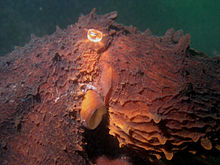Enteroctopus
| Giant octopus | |
|---|---|

| |
| E. dofleini showing longitudinal folds and paddle-like papillae diagnostic for the genus. | |
| Scientific classification | |
| Kingdom: | |
| Phylum: | |
| Class: | |
| Order: | |
| Family: | |
| Subfamily: | |
| Genus: | Enteroctopus Rochebrune & Mabille, 1889
|
| Species | |
|
Enteroctopus dofleini | |
Enteroctopus is an octopus genus whose members are sometimes known as giant octopuses.
Description
Enteroctopus is a genus of generally temperate octopus. Members of the genus Enteroctopus are characterized by their large size and are often known as the giant octopuses. Enteroctopus species have distinct longitudinal wrinkles or folds dorsally and laterally on the body. The head is distinctly narrower than the mantle width. The hectocotylus of the males in this genus, found on the third right arm, is long and narrow in comparison with other genera in the family Octopodidae, often comprising one fifth the length of the arm. Octopuses in this genus have large paddle-like papillae instead of the more conical papillae in other octopus genera.[1][2]
Type species
Enteroctopus membranaceus has often been regarded as type species of the genus, not because it was designated as such by Rochebrune and Mabille when they erected the genus, but because it was the first named species in the genus. Robson in his 1929 monograph of octopods regarded E. membranaceus as a species dubium because the original description was insufficient to identify an individual species, the holotype was an immature specimen, and the type specimen was no longer extant. As such, the genus was considered invalid until Hochberg resurrected it in 1998. Hochberg noted that Robson had considered E. membranaceus a junior synonym of E. megalocyathus, the second species assigned to the genus by Rochebrune and Mabille in their 1889 description. Additionally, since Rochebrune and Mabille did not actually assign type status to E. membranaceus, Hochberg concluded that Enteroctopus was indeed a valid genus and transferred type species status to E. megalocyathus by virtual monotypy.[1]
Distribution

Species in the genus Enteroctopus are restricted to the temperate areas of the Northern and Southern Hemispheres. E. dofleini is the only member of the genus found in the Northern Hemisphere and also the most widely distributed, occurring from San Diego, California along the North Pacific Rim to Japan, including the Okhotsk and Bering Seas.[1] The other three species are found in the Southern Hemisphere; E. megalocyathus occurs on the southeastern coast of South America,[3] E. magnificus on the southwestern coast of Africa from Namibia to Port Elizabeth, South Africa, and E. zealandicus in temperate New Zealand.[2]
Size
[4] The member of this genus that best embodies the common name "giant octopus" is Enteroctopus dofleini, which holds the record of being the world's largest octopus based on direct measurements of a 71 kilograms (157 pounds) individual, weighed live.[5] This octopus had a total length near to 3.3 metres (11 feet). The remaining members of the genus are substantially smaller, with E. megalocyathus having an average mass of 4 kilograms (8.8 pounds) and reaching a total length of 1.0 metre (3.3 feet).[6][7] E. magnificus reaches a total length of around 1.5 metres (4.9 feet).[2]
Species
- Genus Enteroctopus[8]
- Enteroctopus dofleini, Giant Pacific Octopus
- Enteroctopus magnificus, Southern Giant Octopus
- Enteroctopus megalocyathus
- Enteroctopus zealandicus
See also
References
- ^ a b c Hochberg, F.G. (1998). Enteroctopus. In: Taxonomic atlas of the benthic fauna of the Santa Maria Basin and the Western Santa Barbara Channel. Santa Barbara Museum of Natural History, Santa Barbara, California. p. 203.
- ^ a b c Norman, M. (2003). Cephalopods: A World Guide. ConchBooks: Heckenhaim, Germany. pp. 213–216.
- ^ CephBase: Countries' Exclusive Economic Zones with Enteroctopus megalocyathus
- ^ The size record is held by a specimen that was 30 feet (9.1 meters) across and weighed more than 600 pounds (272 kilograms). Averages are more like 16 feet (5 meters) and 110 lbs (50 kilograms). National Geographic(2014)
- ^ Cosgrove, J.A. (1987).Aspects of the Natural History of Octopus dofleini, the Giant Pacific Octopus. M.Sc. Thesis. Department of Biology, University of Victoria (Canada), 101 pp.
- ^ Perez, M.C., D.A. Lopez, K. Aguila and M.L. Gonzalez (2006). Feeding and growth in captivity of the octopus Enteroctopus megalocyathus Gould, 1852. Aquaculture Research 37: 550–555.
- ^ Gleadall, I.G. and M.A. Salcedo-Vargas (2004). Catalogue of the Cephalopoda Specimens in the Zoology Department of Tokyo University Museum. Interdisciplinary Information Sciences 10: 113–142.
- ^ Norman, M.D. & F.G. Hochberg (2005). The current state of octopus taxonomy. Phuket Marine Biological Center Research Bulletin 66: 127–154.
